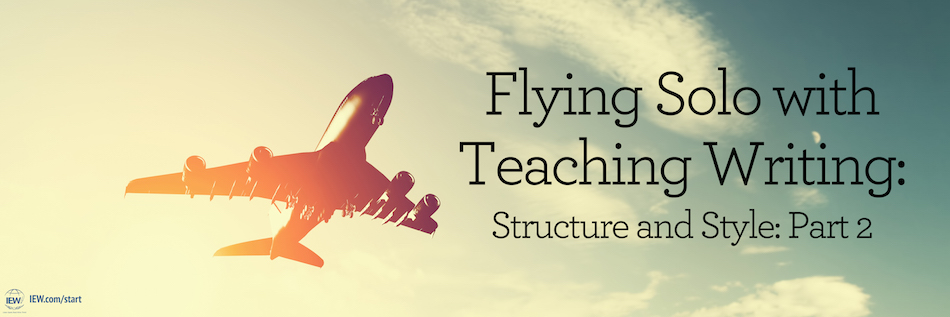
In our last blog post, we described the initial steps you need to take in order to plan for a successful year utilizing our flagship course, Teaching Writing: Structure and Style, as the foundation. In this continuing post we will proceed to lay out the steps, focusing on what types of source material work best for each unit as well as how to design an appropriate checklist and develop your own preparatory and practice materials.
The source material should be selected with two criteria. First, it must fit the model, and second, it must be at or below the reading level of the student(s). While the second criterion is relatively easy to determine, the first requires a bit more thinking and experience.
Units 1 and 2 source texts generally are short, interesting, and with not too many compound or complex sentences. Remember that students will be taking a maximum of three key words from each sentence. (Again, looking at the variety of source texts in the second edition Teaching Writing: Structure and Style Seminar Workbook will be helpful here.) Aesop fables are always great; they can be used with seven-year-olds as well as seventeen-year-olds.
Unit 3 source texts must be stories that contain basic narrative elements: characters/setting, problem/conflict, climax/resolution. These stories can be any length even though the student compositions will be three paragraphs; however, stories that are too long or complicated will be harder to fit into three paragraphs.
Unit 4 source texts can be longer and generally should have more facts than the target length of one paragraph per topic. Refer to TWSS2 Unit 4 for an explanation of the funnel idea; the more facts contained in the source text, the harder it will be to “some-a-rize.” (Some-a-rize means choose some, but not all, of the facts to put in the outline and retell in the composition.) Because key words should be taken from facts, not sentences, sentence length is not important. Additionally, source text content should, when possible, be connected with areas of interest or study such as history, science, or literature. (Theme-based writing lessons have source texts with theme-connected content, but this is not necessary.) It is still important that the source texts be at or below the reading level of the student(s).
Unit 5 uses pictures, not source texts. See TWSS2 for a discussion of picture sources.
Unit 6 uses multiple sources, probably in two stages. Stage One requires materials chosen by you which are vetted, in other words, selected, so they would be almost guaranteed to work. IEW provides helpful mini-books (such as those found in the TWSS2 and SWI courses), which are created to assist you in this stage of teaching the model and the process to a group of students with easy-to-use, short, duplicable materials. Stage Two happens after the process has been learned. In this stage, sources now begin to include material found by the students themselves with assistance from you as needed. Again, source texts should always be at or below the reading level of the student(s).
Unit 7 does not require source texts.
Unit 8 uses sources similar to Units 4 and 6, for the most part chosen by students, especially for second or third year students.
Unit 9 uses sources similar to Unit 3. See TWSS2 for general guidelines.
Once the sources are selected, the teacher determines the Style Checklist by following the formula “EZ+1” as articulated in TWSS2, and it therefore should not be planned too far in advance. Ideally, the checklist for each successive assignment would be determined based on the previous assignment: Did the students use the checklist for the most recent assignment and demonstrate that they can do it “without much help, and it doesn’t sound too goofy most of the time” (the definition of easy from TWSS2)?
Note: IEW’s theme-based writing lessons provide a predetermined checklist; however, we are always reminding teachers and parents that the published checklist is only a suggested guideline, and it should be adjusted for individual students or groups of students to follow the basic principle of “EZ+1.”
Additionally, a recent feature included for all Premium Subscribers is IEW’s Premium Checklist Generator, which makes creating custom checklists a snap.
Preparatory and practice activities are needed mostly when a new style technique is introduced. Most typically this would include creating, adding to, or reviewing word lists; constructing practice sentences with new style techniques (openers, clauses, and decorations); or reviewing sample compositions—preferably from students—to identify and learn by example structural and stylistic elements in finished works. These also are generally most effective when not planned far in advance, but devised by the skilled parent/teacher at the point of need.
Teaching writing utilizing Teaching Writing: Structure and Style “solo” is certainly possible. Not only that, it can be highly rewarding. If you are interested in doing just that, grab your TWSS off the shelf and watch and complete the practicum assignments. Then start planning! A year of custom-designed writing curriculum awaits!
